You have an app named App1 that uses two on-premises Microsoft SQL Server databases named DB1 and DB2.
You plan to migrate DB1 and DB2 to Azure
You need to recommend an Azure solution to host DB1 and DB2. The solution must meet the following requirements:
✑ Support server-side transactions across DB1 and DB2.
✑ Minimize administrative effort to update the solution.
What should you recommend?
- A. two Azure SQL databases in an elastic pool
- B. two databases on the same Azure SQL managed instance
- C. two databases on the same SQL Server instance on an Azure virtual machine
- D. two Azure SQL databases on different Azure SQL Database servers
Answer : B
Explanation:
Elastic database transactions for Azure SQL Database and Azure SQL Managed Instance allow you to run transactions that span several databases.
SQL Managed Instance enables system administrators to spend less time on administrative tasks because the service either performs them for you or greatly simplifies those tasks.
Reference:
https://docs.microsoft.com/en-us/azure/azure-sql/database/elastic-transactions-overview?view=azuresql
You need to design a highly available Azure SQL database that meets the following requirements:
✑ Failover between replicas of the database must occur without any data loss.
✑ The database must remain available in the event of a zone outage.
✑ Costs must be minimized.
Which deployment option should you use?
- A. Azure SQL Database Hyperscale
- B. Azure SQL Database Premium
- C. Azure SQL Database Basic
- D. Azure SQL Managed Instance General Purpose
Answer : B
Explanation:
Azure SQL Database Premium tier supports multiple redundant replicas for each database that are automatically provisioned in the same datacenter within a region. This design leverages the SQL Server AlwaysON technology and provides resilience to server failures with 99.99% availability SLA and RPO=0.
With the introduction of Azure Availability Zones, we are happy to announce that SQL Database now offers built-in support of Availability Zones in its Premium service tier.
Incorrect:
Not A: Hyperscale is more expensive than Premium.
Not C: Need Premium for Availability Zones.
Not D: Zone redundant configuration that is free on Azure SQL Premium is not available on Azure SQL Managed Instance.
Reference:
https://azure.microsoft.com/en-us/blog/azure-sql-database-now-offers-zone-redundant-premium-databases-and-elastic-pools/
HOTSPOT -
You are planning an Azure Storage solution for sensitive data. The data will be accessed daily. The dataset is less than 10 GB.
You need to recommend a storage solution that meets the following requirements:
✑ All the data written to storage must be retained for five years.
✑ Once the data is written, the data can only be read. Modifications and deletion must be prevented.
✑ After five years, the data can be deleted, but never modified.
✑ Data access charges must be minimized.
What should you recommend? To answer, select the appropriate options in the answer area.
NOTE: Each correct selection is worth one point.
Hot Area:
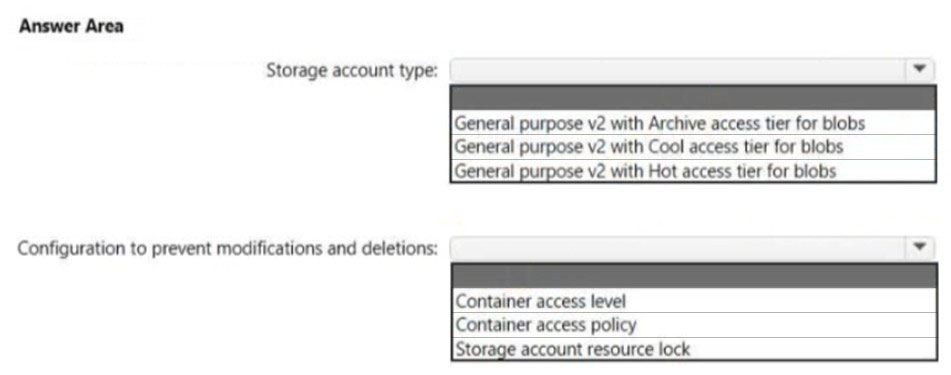
Answer :
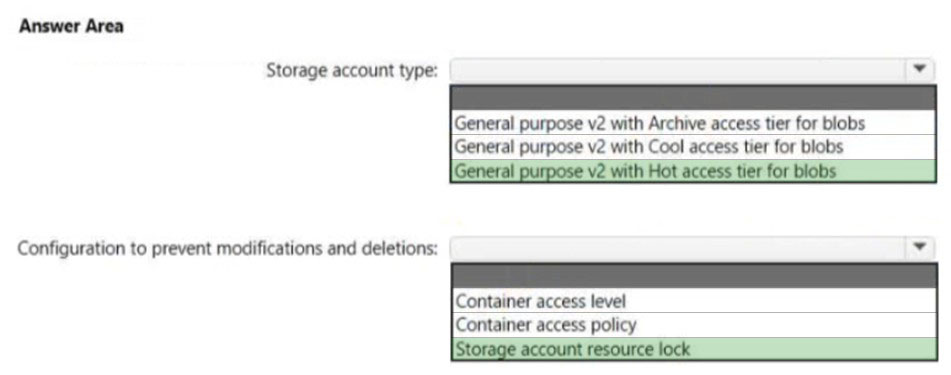
Explanation:
Box 1: General purpose v2 with Hot access tier for blobs
Note:
* All the data written to storage must be retained for five years.
* Data access charges must be minimized
Hot tier has higher storage costs, but lower access and transaction costs.
Incorrect:
Not Archive: Lowest storage costs, but highest access, and transaction costs.
Not Cool: Lower storage costs, but higher access and transaction costs.
Box 2: Storage account resource lock
As an administrator, you can lock a subscription, resource group, or resource to prevent other users in your organization from accidentally deleting or modifying critical resources. The lock overrides any permissions the user might have.
Reference:
https://docs.microsoft.com/en-us/azure/storage/blobs/access-tiers-overview https://docs.microsoft.com/en-us/azure/azure-resource-manager/management/lock-resources
HOTSPOT -
You are designing a data storage solution to support reporting.
The solution will ingest high volumes of data in the JSON format by using Azure Event Hubs. As the data arrives, Event Hubs will write the data to storage. The solution must meet the following requirements:
✑ Organize data in directories by date and time.
✑ Allow stored data to be queried directly, transformed into summarized tables, and then stored in a data warehouse.
✑ Ensure that the data warehouse can store 50 TB of relational data and support between 200 and 300 concurrent read operations.
Which service should you recommend for each type of data store? To answer, select the appropriate options in the answer area.
NOTE: Each correct selection is worth one point.
Hot Area:
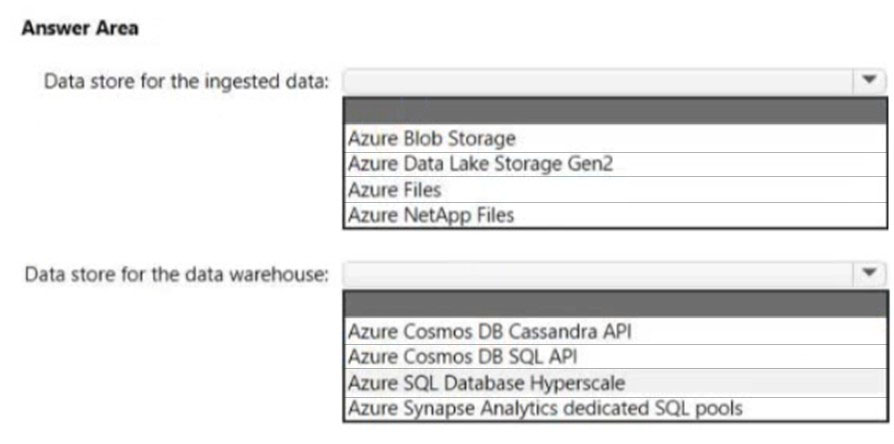
Answer :
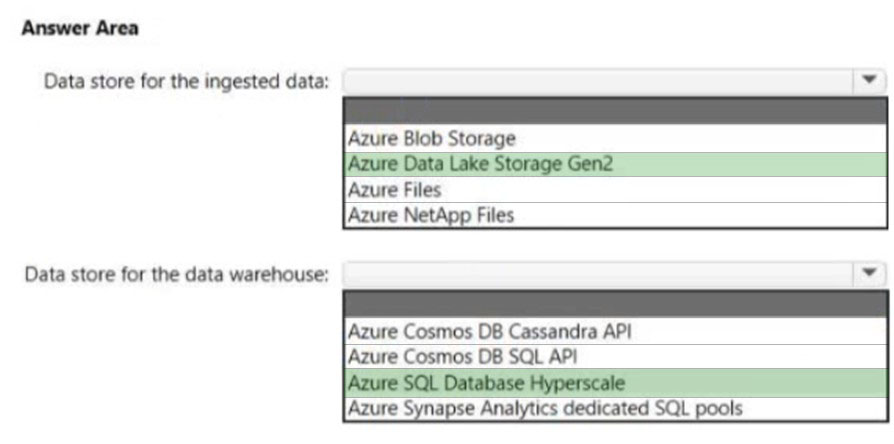
Explanation:
Box 1: Azure Data Lake Storage Gen2
Azure Data Explorer integrates with Azure Blob Storage and Azure Data Lake Storage (Gen1 and Gen2), providing fast, cached, and indexed access to data stored in external storage. You can analyze and query data without prior ingestion into Azure Data Explorer. You can also query across ingested and uningested external data simultaneously.
Azure Data Lake Storage is optimized storage for big data analytics workloads.
Use cases: Batch, interactive, streaming analytics and machine learning data such as log files, IoT data, click streams, large datasets
Box 2: Azure SQL Database Hyperscale
Azure SQL Database Hyperscale is optimized for OLTP and high throughput analytics workloads with storage up to 100TB.
A Hyperscale database supports up to 100 TB of data and provides high throughput and performance, as well as rapid scaling to adapt to the workload requirements. Connectivity, query processing, database engine features, etc. work like any other database in Azure SQL Database.
Hyperscale is a multi-tiered architecture with caching at multiple levels. Effective IOPS will depend on the workload.
Compare to:
General purpose: 500 IOPS per vCore with 7,000 maximum IOPS
Business critical: 5,000 IOPS with 200,000 maximum IOPS
Incorrect:
* Azure Synapse Analytics Dedicated SQL pool.
Max database size: 240 TB -
A maximum of 128 concurrent queries will execute and remaining queries will be queued.
Reference:
https://docs.microsoft.com/en-us/azure/data-explorer/data-lake-query-data https://docs.microsoft.com/en-us/azure/azure-sql/database/service-tier-hyperscale https://docs.microsoft.com/en-us/azure/synapse-analytics/sql-data-warehouse/sql-data-warehouse-service-capacity-limits
Case Study -
This is a case study. Case studies are not timed separately. You can use as much exam time as you would like to complete each case. However, there may be additional case studies and sections on this exam. You must manage your time to ensure that you are able to complete all questions included on this exam in the time provided.
To answer the questions included in a case study, you will need to reference information that is provided in the case study. Case studies might contain exhibits and other resources that provide more information about the scenario that is described in the case study. Each question is independent of the other questions in this case study.
At the end of this case study, a review screen will appear. This screen allows you to review your answers and to make changes before you move to the next section of the exam. After you begin a new section, you cannot return to this section.
To start the case study -
To display the first question in this case study, click the Next button. Use the buttons in the left pane to explore the content of the case study before you answer the questions. Clicking these buttons displays information such as business requirements, existing environment, and problem statements. If the case study has an All Information tab, note that the information displayed is identical to the information displayed on the subsequent tabs. When you are ready to answer a question, click the Question button to return to the question.
Overview -
Contoso, Ltd. is a research company that has a main office in Montreal.
Existing Environment: Technical Environment
The on-premises network contains a single Active Directory domain named contoso.com.
Contoso has a single Azure subscription.
Existing Environment: Business Partnerships
Contoso has a business partnership with Fabrikam, Inc. Fabrikam users access some Contoso applications over the internet by using Azure Active Directory
(Azure AD) guest accounts.
Requirements: Planned Changes -
Contoso plans to deploy two applications named App1 and App2 to Azure.
Requirements: App1 -
App1 will be a Python web app hosted in Azure App Service that requires a Linux runtime. Users from Contoso and Fabrikam will access App1.
App1 will access several services that require third-party credentials and access strings. The credentials and access strings are stored in Azure Key Vault.
App1 will have six instances: three in the East US Azure region and three in the West Europe Azure region.
App1 has the following data requirements:
Each instance will write data to a data store in the same availability zone as the instance.
Data written by any App1 instance must be visible to all App1 instances.
App1 will only be accessible from the internet. App1 has the following connection requirements:
Connections to App1 must pass through a web application firewall (WAF).
Connections to App1 must be active-active load balanced between instances.
All connections to App1 from North America must be directed to the East US region. All other connections must be directed to the West Europe region.
Every hour, you will run a maintenance task by invoking a PowerShell script that copies files from all the App1 instances. The PowerShell script will run from a central location.
Requirements: App2 -
App2 will be a .NET app hosted in App Service that requires a Windows runtime. App2 has the following file storage requirements:
Save files to an Azure Storage account.
Replicate files to an on-premises location.
Ensure that on-premises clients can read the files over the LAN by using the SMB protocol.
You need to monitor App2 to analyze how long it takes to perform different transactions within the application. The solution must not require changes to the application code.
Application Development Requirements
Application developers will constantly develop new versions of App1 and App2. The development process must meet the following requirements:
A staging instance of a new application version must be deployed to the application host before the new version is used in production.
After testing the new version, the staging version of the application will replace the production version.
The switch to the new application version from staging to production must occur without any downtime of the application.
Identity Requirements -
Contoso identifies the following requirements for managing Fabrikam access to resources:
Every month, an account manager at Fabrikam must review which Fabrikam users have access permissions to App1. Accounts that no longer need permissions must be removed as guests.
The solution must minimize development effort.
Security Requirement -
All secrets used by Azure services must be stored in Azure Key Vault.
Services that require credentials must have the credentials tied to the service instance. The credentials must NOT be shared between services.
HOTSPOT -
You are evaluating whether to use Azure Traffic Manager and Azure Application Gateway to meet the connection requirements for App1.
What is the minimum numbers of instances required for each service? To answer, select the appropriate options in the answer area.
NOTE: Each correct selection is worth one point.
Hot Area:
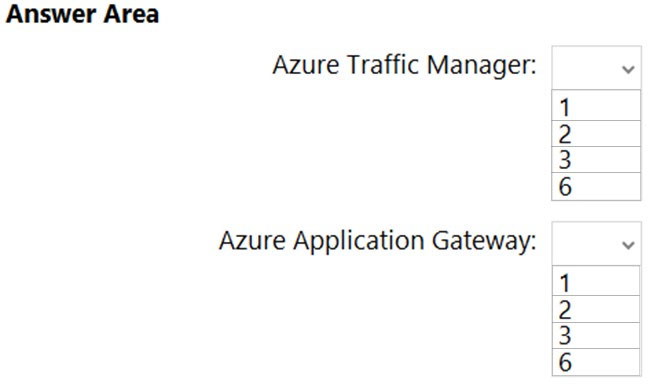
Answer :
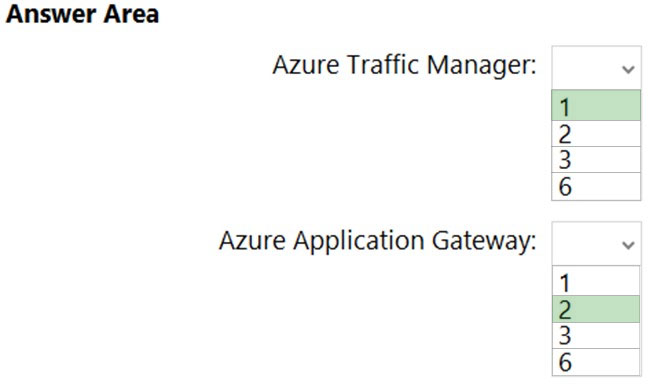
Explanation:
Box 1: 1 -
App1 will only be accessible from the internet. App1 has the following connection requirements:
ג€¢ Connections to App1 must be active-active load balanced between instances.
ג€¢ All connections to App1 from North America must be directed to the East US region. All other connections must be directed to the West Europe region.
App1 will have six instances: three in the East US Azure region and three in the West Europe Azure region.
Note: Azure Traffic Manager is a DNS-based traffic load balancer. This service allows you to distribute traffic to your public facing applications across the global
Azure regions.
Box 2: 2 -
For production workloads, run at least two gateway instances.
A single Application Gateway deployment can run multiple instances of the gateway.
Use one Application Gateway in East US Region, and one in the West Europe region.
Reference:
https://docs.microsoft.com/en-us/azure/architecture/high-availability/reference-architecture-traffic-manager-application-gateway
Case Study -
This is a case study. Case studies are not timed separately. You can use as much exam time as you would like to complete each case. However, there may be additional case studies and sections on this exam. You must manage your time to ensure that you are able to complete all questions included on this exam in the time provided.
To answer the questions included in a case study, you will need to reference information that is provided in the case study. Case studies might contain exhibits and other resources that provide more information about the scenario that is described in the case study. Each question is independent of the other questions in this case study.
At the end of this case study, a review screen will appear. This screen allows you to review your answers and to make changes before you move to the next section of the exam. After you begin a new section, you cannot return to this section.
To start the case study -
To display the first question in this case study, click the Next button. Use the buttons in the left pane to explore the content of the case study before you answer the questions. Clicking these buttons displays information such as business requirements, existing environment, and problem statements. If the case study has an All Information tab, note that the information displayed is identical to the information displayed on the subsequent tabs When you are ready to answer a question, click the Question button to return to the question.
Overview -
Litware, Inc. is a medium-sized finance company that has a main office in Boston.
Existing Environment -
Identity Environment -
The network contains an Active Directory forest named litware.com that is linked to an Azure Active Directory (Azure AD) tenant named litware.com. All users have Azure Active Directory Premium P2 licenses.
Litware has a second Azure AD tenant named dev.litware.com that is used as a development environment.
The litware.com tenant has a Conditional Access policy named Capolicy1. Capolicy1 requires that when users manage the Azure subscription for a production environment by using the Azure portal, they must connect from a hybrid Azure AD-joined device.
Azure Environment -
Litware has 10 Azure subscriptions that are linked to the Litware.com tenant and five Azure subscriptions that are linked to the dev.litware.com tenant. All the subscriptions are in an Enterprise Agreement (EA).
The litware.com tenant contains a custom Azure role-based access control (Azure RBAC) role named Role1 that grants the DataActions read permission to the blobs and files in Azure Storage.
On-Premises Environment -
The on-premises network of Litware contains the resources shown in the following table.
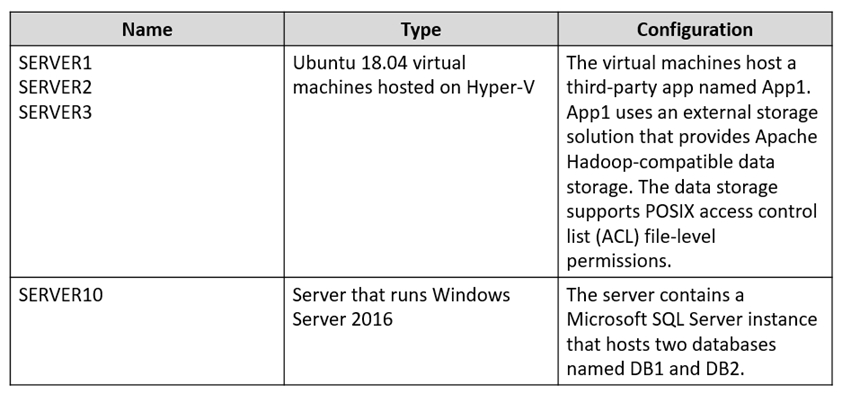
Network Environment -
Litware has ExpressRoute connectivity to Azure.
Planned Changes and Requirements
Planned Changes -
Litware plans to implement the following changes:
Migrate DB1 and DB2 to Azure.
Migrate App1 to Azure virtual machines.
Migrate the external storage used by App1 to Azure Storage.
Deploy the Azure virtual machines that will host App1 to Azure dedicated hosts.

Authentication and Authorization Requirements
Litware identifies the following authentication and authorization requirements:
Only users that manage the production environment by using the Azure portal must connect from a hybrid Azure AD-joined device and authenticate by using
Azure Multi-Factor Authentication (MFA).
The Network Contributor built-in RBAC role must be used to grant permissions to the network administrators for all the virtual networks in all the Azure subscriptions.
To access the resources in Azure, App1 must use the managed identity of the virtual machines that will host the app.
RBAC roles must be applied to management groups.
Resiliency Requirements -
Litware identifies the following resiliency requirements:
Once migrated to Azure, DB1 and DB2 must meet the following requirements:
- Maintain availability if two availability zones in the local Azure region fail.
- Fail over automatically.
- Minimize I/O latency.
App1 must meet the following requirements:
- Be hosted in an Azure region that supports availability zones.
- Be hosted on Azure virtual machines that support automatic scaling.
- Maintain availability if two availability zones in the local Azure region fail.
Security and Compliance Requirements
Litware identifies the following security and compliance requirements:
Once App1 is migrated to Azure, you must ensure that new data can be written to the app, and the modification of new and existing data is prevented for a period of three years.
On-premises users and services must be able to access the Azure Storage account that will host the data in App1.
Access to the public endpoint of the Azure Storage account that will host the App1 data must be prevented.
All Azure SQL databases in the production environment must have Transparent Data Encryption (TDE) enabled.
App1 must NOT share physical hardware with other workloads.
Business Requirements -
Litware identifies the following business requirements:
Minimize administrative effort.
Minimize costs.

HOTSPOT -
How should the migrated databases DB1 and DB2 be implemented in Azure?
Hot Area:
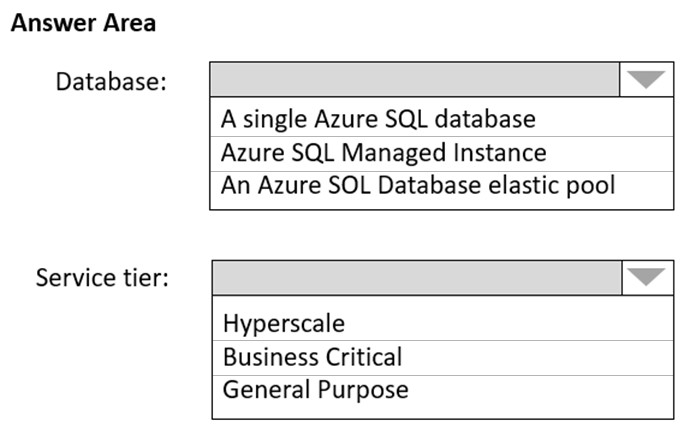
Answer :
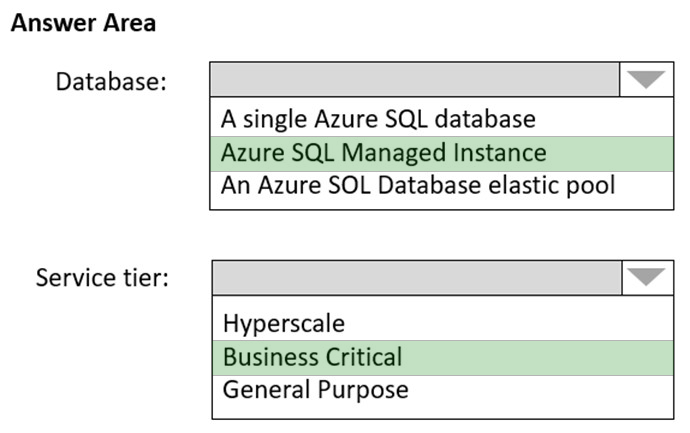
Explanation:
Box 1: SQL Managed Instance -
Scenario: Once migrated to Azure, DB1 and DB2 must meet the following requirements:
✑ Maintain availability if two availability zones in the local Azure region fail.
✑ Fail over automatically.
✑ Minimize I/O latency.
The auto-failover groups feature allows you to manage the replication and failover of a group of databases on a server or all databases in a managed instance to another region. It is a declarative abstraction on top of the existing active geo-replication feature, designed to simplify deployment and management of geo- replicated databases at scale. You can initiate a geo-failover manually or you can delegate it to the Azure service based on a user-defined policy. The latter option allows you to automatically recover multiple related databases in a secondary region after a catastrophic failure or other unplanned event that results in full or partial loss of the SQL Database or SQL Managed Instance availability in the primary region.
Box 2: Business critical -
SQL Managed Instance is available in two service tiers:
General purpose: Designed for applications with typical performance and I/O latency requirements.
Business critical: Designed for applications with low I/O latency requirements and minimal impact of underlying maintenance operations on the workload.
Reference:
https://docs.microsoft.com/en-us/azure/azure-sql/database/auto-failover-group-overview https://docs.microsoft.com/en-us/azure/azure-sql/managed-instance/sql-managed-instance-paas-overview
Case Study -
This is a case study. Case studies are not timed separately. You can use as much exam time as you would like to complete each case. However, there may be additional case studies and sections on this exam. You must manage your time to ensure that you are able to complete all questions included on this exam in the time provided.
To answer the questions included in a case study, you will need to reference information that is provided in the case study. Case studies might contain exhibits and other resources that provide more information about the scenario that is described in the case study. Each question is independent of the other questions in this case study.
At the end of this case study, a review screen will appear. This screen allows you to review your answers and to make changes before you move to the next section of the exam. After you begin a new section, you cannot return to this section.
To start the case study -
To display the first question in this case study, click the Next button. Use the buttons in the left pane to explore the content of the case study before you answer the questions. Clicking these buttons displays information such as business requirements, existing environment, and problem statements. If the case study has an All Information tab, note that the information displayed is identical to the information displayed on the subsequent tabs. When you are ready to answer a question, click the Question button to return to the question.
Overview -
Fabrikam, Inc. is an engineering company that has offices throughout Europe. The company has a main office in London and three branch offices in Amsterdam,
Berlin, and Rome.
Existing Environment: Active Directory Environment
The network contains two Active Directory forests named corp.fabrikam.com and rd.fabrikam.com. There are no trust relationships between the forests.
Corp.fabrikam.com is a production forest that contains identities used for internal user and computer authentication.
Rd.fabrikam.com is used by the research and development (R&D) department only. The R&D department is restricted to using on-premises resources only.
Existing Environment: Network Infrastructure
Each office contains at least one domain controller from the corp.fabrikam.com domain. The main office contains all the domain controllers for the rd.fabrikam.com forest.
All the offices have a high-speed connection to the internet.
An existing application named WebApp1 is hosted in the data center of the London office. WebApp1 is used by customers to place and track orders. WebApp1 has a web tier that uses Microsoft Internet Information Services (IIS) and a database tier that runs Microsoft SQL Server 2016. The web tier and the database tier are deployed to virtual machines that run on Hyper-V.
The IT department currently uses a separate Hyper-V environment to test updates to WebApp1.
Fabrikam purchases all Microsoft licenses through a Microsoft Enterprise Agreement that includes Software Assurance.
Existing Environment: Problem Statements
The use of WebApp1 is unpredictable. At peak times, users often report delays. At other times, many resources for WebApp1 are underutilized.
Requirements: Planned Changes -
Fabrikam plans to move most of its production workloads to Azure during the next few years, including virtual machines that rely on Active Directory for authentication.
As one of its first projects, the company plans to establish a hybrid identity model, facilitating an upcoming Microsoft 365 deployment.
All R&D operations will remain on-premises.
Fabrikam plans to migrate the production and test instances of WebApp1 to Azure.
Requirements: Technical Requirements
Fabrikam identifies the following technical requirements:
Website content must be easily updated from a single point.
User input must be minimized when provisioning new web app instances.
Whenever possible, existing on-premises licenses must be used to reduce cost.
Users must always authenticate by using their corp.fabrikam.com UPN identity.
Any new deployments to Azure must be redundant in case an Azure region fails.
Whenever possible, solutions must be deployed to Azure by using the Standard pricing tier of Azure App Service.
An email distribution group named IT Support must be notified of any issues relating to the directory synchronization services.
In the event that a link fails between Azure and the on-premises network, ensure that the virtual machines hosted in Azure can authenticate to Active Directory.
Directory synchronization between Azure Active Directory (Azure AD) and corp.fabrikam.com must not be affected by a link failure between Azure and the on- premises network.
Requirements: Database Requirements
Fabrikam identifies the following database requirements:
Database metrics for the production instance of WebApp1 must be available for analysis so that database administrators can optimize the performance settings.
To avoid disrupting customer access, database downtime must be minimized when databases are migrated.
Database backups must be retained for a minimum of seven years to meet compliance requirements.
Requirements: Security Requirements
Fabrikam identifies the following security requirements:
Company information including policies, templates, and data must be inaccessible to anyone outside the company.
Users on the on-premises network must be able to authenticate to corp.fabrikam.com if an internet link fails.
Administrators must be able authenticate to the Azure portal by using their corp.fabrikam.com credentials.
All administrative access to the Azure portal must be secured by using multi-factor authentication (MFA).
The testing of WebApp1 updates must not be visible to anyone outside the company.
HOTSPOT -
You design a solution for the web tier of WebApp1 as shown in the exhibit.
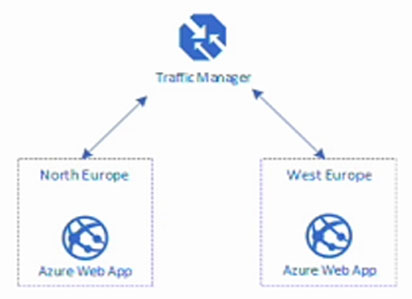
For each of the following statements, select Yes if the statement is true. Otherwise, select No.
NOTE: Each correct selection is worth one point.
Hot Area:

Answer :

Explanation:
Box 1: Yes -
Any new deployments to Azure must be redundant in case an Azure region fails.
Traffic Manager is resilient to failure, including the failure of an entire Azure region.
Box 2: No -
Traffic Manager provides load balancing, but not auto-scaling.
Box 3: No -
Automatic failover using Azure Traffic Manager: when you have complex architectures and multiple sets of resources capable of performing the same function, you can configure Azure Traffic Manager (based on DNS) to check the health of your resources and route the traffic from the non-healthy resource to the healthy resource.
Reference:
https://docs.microsoft.com/en-us/azure/traffic-manager/traffic-manager-overview https://docs.microsoft.com/en-us/azure/networking/disaster-recovery-dns-traffic-manager
You have SQL Server on an Azure virtual machine. The databases are written to nightly as part of a batch process.
You need to recommend a disaster recovery solution for the data. The solution must meet the following requirements:
✑ Provide the ability to recover in the event of a regional outage.
✑ Support a recovery time objective (RTO) of 15 minutes.
✑ Support a recovery point objective (RPO) of 24 hours.
✑ Support automated recovery.
✑ Minimize costs.
What should you include in the recommendation?
- A. Azure virtual machine availability sets
- B. Azure Disk Backup
- C. an Always On availability group
- D. Azure Site Recovery
Answer : D
Explanation:
Replication with Azure Site Recover:
✑ RTO is typically less than 15 minutes.
✑ RPO: One hour for application consistency and five minutes for crash consistency.
Incorrect Answers:
B: Too slow.
C: Always On availability group RPO: Because replication to the secondary replica is asynchronous, there's some data loss.
Reference:
https://docs.microsoft.com/en-us/azure/site-recovery/site-recovery-sql
HOTSPOT -
You plan to deploy the backup policy shown in the following exhibit.
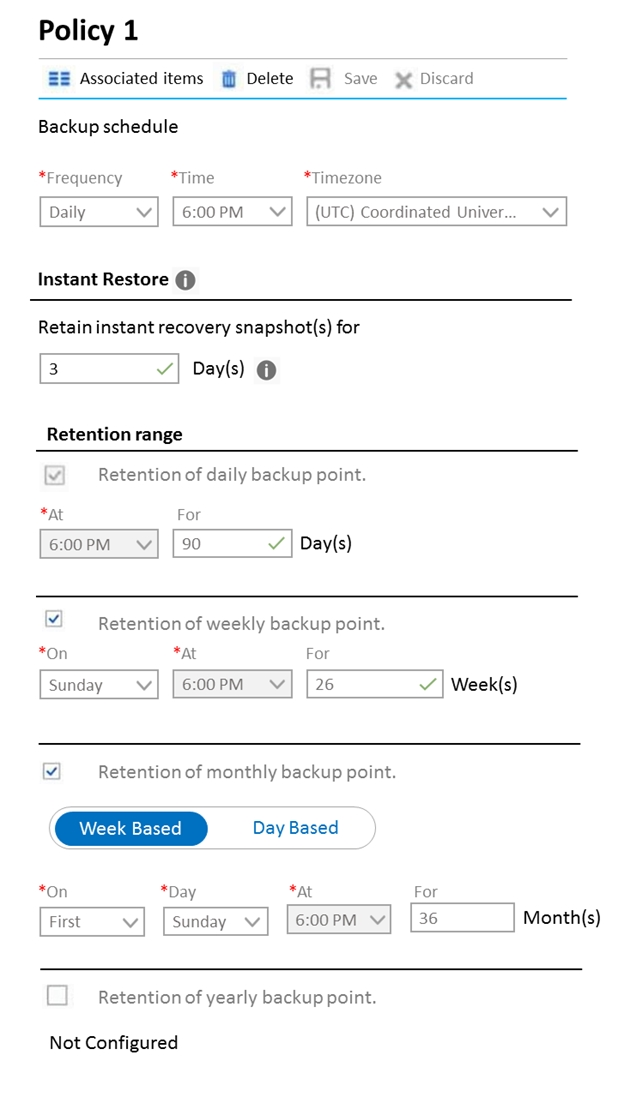
Use the drop-down menus to select the answer choice that completes each statement based on the information presented in the graphic.
NOTE: Each correct selection is worth one point.
Hot Area:
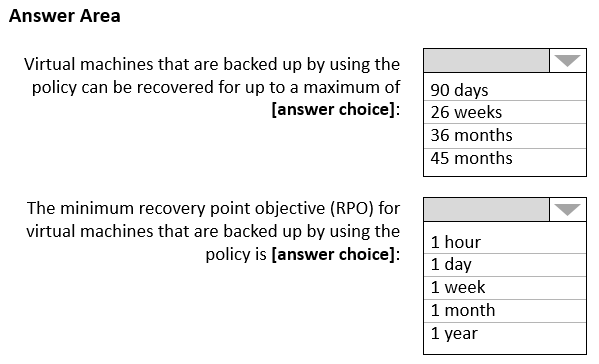
Answer :
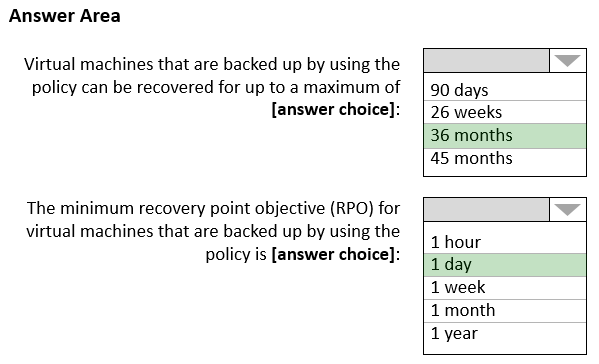
Note: This question is part of a series of questions that present the same scenario. Each question in the series contains a unique solution that might meet the stated goals. Some question sets might have more than one correct solution, while others might not have a correct solution.
After you answer a question in this section, you will NOT be able to return to it. As a result, these questions will not appear in the review screen.
You need to deploy resources to host a stateless web app in an Azure subscription. The solution must meet the following requirements:
✑ Provide access to the full .NET framework.
Provide redundancy if an Azure region fails.

✑ Grant administrators access to the operating system to install custom application dependencies.
Solution: You deploy two Azure virtual machines to two Azure regions, and you create an Azure Traffic Manager profile.
Does this meet the goal?
- A. Yes
- B. No
Answer : A
Explanation:
Azure Traffic Manager is a DNS-based traffic load balancer that enables you to distribute traffic optimally to services across global Azure regions, while providing high availability and responsiveness.
Note: This question is part of a series of questions that present the same scenario. Each question in the series contains a unique solution that might meet the stated goals. Some question sets might have more than one correct solution, while others might not have a correct solution.
After you answer a question in this section, you will NOT be able to return to it. As a result, these questions will not appear in the review screen.
You need to deploy resources to host a stateless web app in an Azure subscription. The solution must meet the following requirements:
✑ Provide access to the full .NET framework.
✑ Provide redundancy if an Azure region fails.
✑ Grant administrators access to the operating system to install custom application dependencies.
Solution: You deploy two Azure virtual machines to two Azure regions, and you deploy an Azure Application Gateway.
Does this meet the goal?
- A. Yes
- B. No
Answer : B
Explanation:
App Gateway will balance the traffic between VMs deployed in the same region. Create an Azure Traffic Manager profile instead.
HOTSPOT -
You plan to create an Azure Storage account that will host file shares. The shares will be accessed from on-premises applications that are transaction intensive.
You need to recommend a solution to minimize latency when accessing the file shares. The solution must provide the highest-level of resiliency for the selected storage tier.
What should you include in the recommendation? To answer, select the appropriate options in the answer area.
NOTE: Each correct selection is worth one point.
Hot Area:
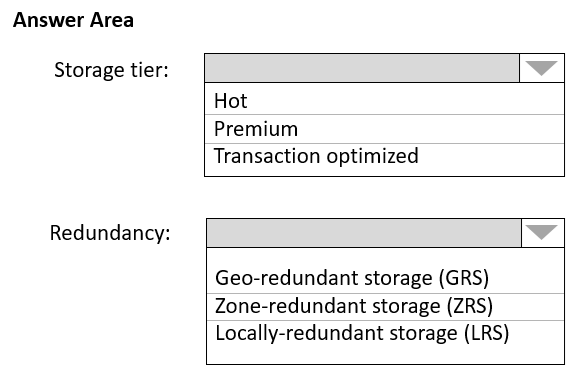
Answer :
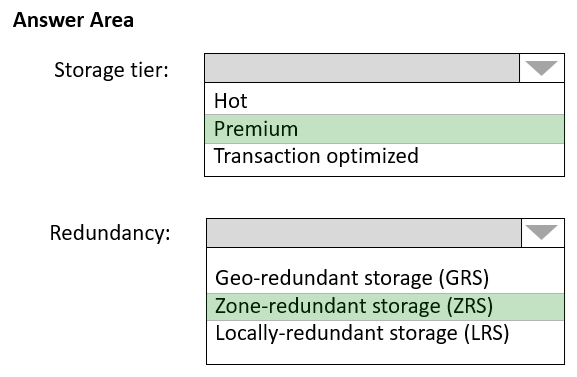
Explanation:
Box 1: Premium -
Premium: Premium file shares are backed by solid-state drives (SSDs) and provide consistent high performance and low latency, within single-digit milliseconds for most IO operations, for IO-intensive workloads.
Incorrect Answers:
✑ Hot: Hot file shares offer storage optimized for general purpose file sharing scenarios such as team shares. Hot file shares are offered on the standard storage hardware backed by HDDs.
✑ Transaction optimized: Transaction optimized file shares enable transaction heavy workloads that don't need the latency offered by premium file shares.
Transaction optimized file shares are offered on the standard storage hardware backed by hard disk drives (HDDs). Transaction optimized has historically been called "standard", however this refers to the storage media type rather than the tier itself (the hot and cool are also "standard" tiers, because they are on standard storage hardware).
Box 2: Zone-redundant storage (ZRS):
Premium Azure file shares only support LRS and ZRS.
Zone-redundant storage (ZRS): With ZRS, three copies of each file stored, however these copies are physically isolated in three distinct storage clusters in different Azure availability zones.
Reference:
https://docs.microsoft.com/en-us/azure/storage/files/storage-files-planning
Note: This question is part of a series of questions that present the same scenario. Each question in the series contains a unique solution that might meet the stated goals. Some question sets might have more than one correct solution, while others might not have a correct solution.
After you answer a question in this section, you will NOT be able to return to it. As a result, these questions will not appear in the review screen.
You need to deploy resources to host a stateless web app in an Azure subscription. The solution must meet the following requirements:
✑ Provide access to the full .NET framework.
✑ Provide redundancy if an Azure region fails.
✑ Grant administrators access to the operating system to install custom application dependencies.
Solution: You deploy an Azure virtual machine scale set that uses autoscaling.
Does this meet the goal?
- A. Yes
- B. No
Answer : B
Explanation:
Instead, you should deploy two Azure virtual machines to two Azure regions, and you create a Traffic Manager profile.
Note: Azure Traffic Manager is a DNS-based traffic load balancer that enables you to distribute traffic optimally to services across global Azure regions, while providing high availability and responsiveness.
Reference:
https://docs.microsoft.com/en-us/azure/traffic-manager/traffic-manager-overview
HOTSPOT -
You need to recommend an Azure Storage account configuration for two applications named Application1 and Application2. The configuration must meet the following requirements:
✑ Storage for Application1 must provide the highest possible transaction rates and the lowest possible latency.
✑ Storage for Application2 must provide the lowest possible storage costs per GB.
✑ Storage for both applications must be available in an event of datacenter failure.
✑ Storage for both applications must be optimized for uploads and downloads.
What should you recommend? To answer, select the appropriate options in the answer area.
NOTE: Each correct selection is worth one point.
Hot Area:
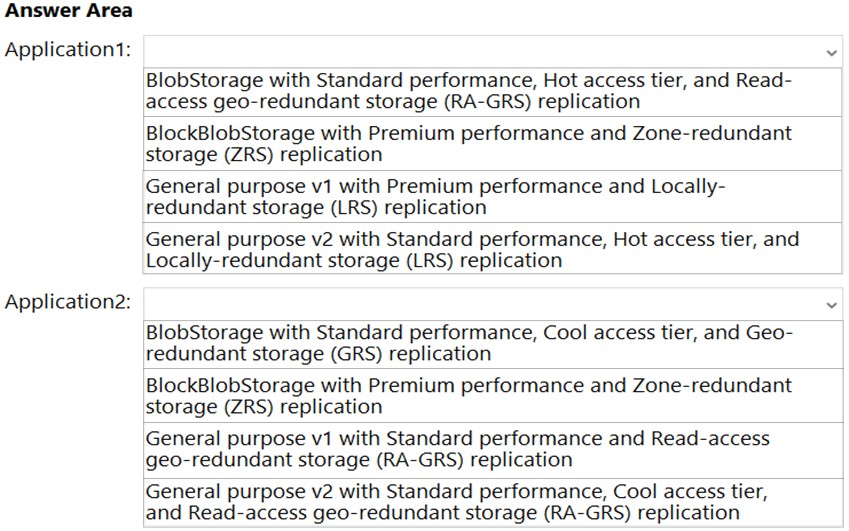
Answer :
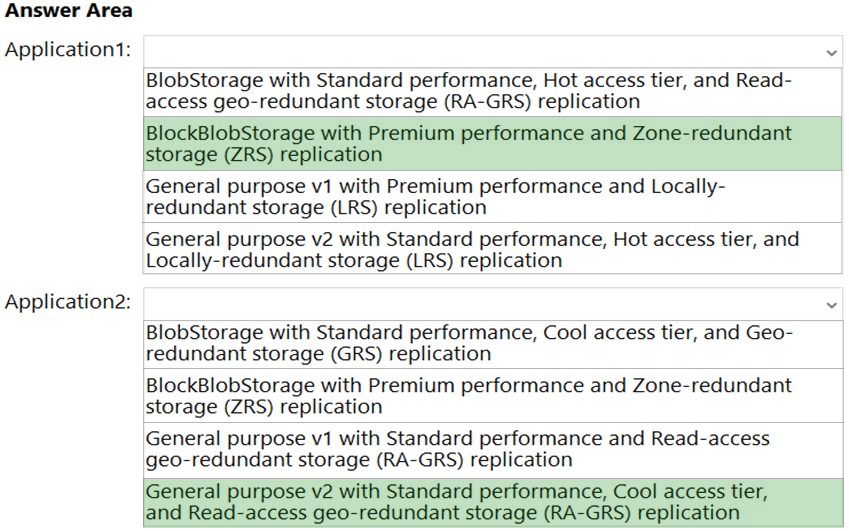
Explanation:
Box 1: BlobStorage with Premium Performance,ג€¦
Application1 requires high transaction rates and the lowest possible latency. We need to use Premium, not Standard.
Box 2: General purpose v2 with Standard Performance,..
General Purpose v2 provides access to the latest Azure storage features, including Cool and Archive storage, with pricing optimized for the lowest GB storage prices. These accounts provide access to Block Blobs, Page Blobs, Files, and Queues. Recommended for most scenarios using Azure Storage.
Reference:
https://docs.microsoft.com/en-us/azure/storage/common/storage-account-upgrade
HOTSPOT -
You plan to develop a new app that will store business critical data. The app must meet the following requirements:
✑ Prevent new data from being modified for one year.
✑ Maximize data resiliency.
✑ Minimize read latency.
What storage solution should you recommend for the app? To answer, select the appropriate options in the answer area.
NOTE: Each correct selection is worth one point.
Hot Area:

Answer :

Box 1: Standard general-purpose v2
Standard general-purpose v2 supports immutable storage.
In general Standard general-purpose v2 is the preferred Microsoft recommendation.
Box 2: Zone-redundant storage (ZRS)
ZRS is more resilient compared to LRS.
Note: RA-GRS is even more resilient, but it is not an option here.
Reference:
https://docs.microsoft.com/en-us/azure/storage/blobs/storage-blob-immutable-storage
No comments:
Post a Comment